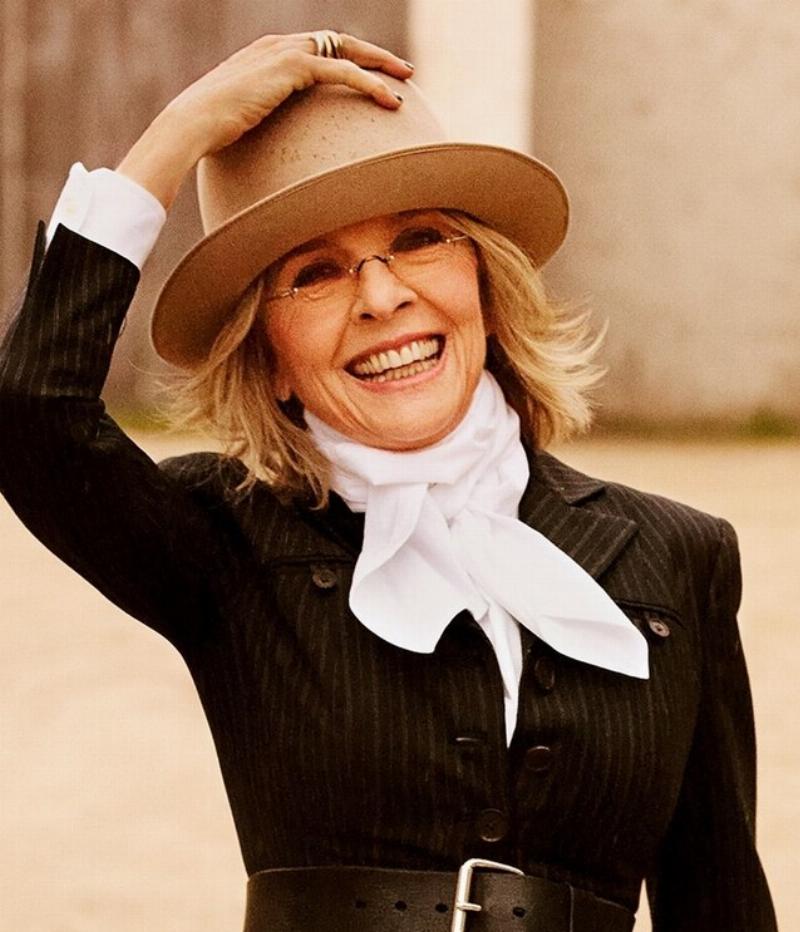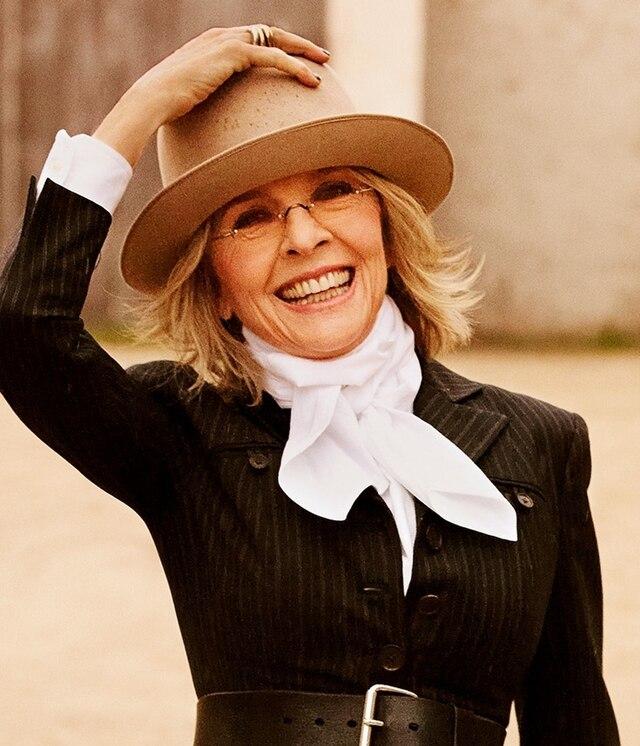


Diane Hall grew up in Santa Ana, California, where she first attended Santa Ana and then Orange Coast community colleges. At 19, she moved to New York to study acting and explore the possibility of becoming a professional actress.
Upon joining the Actors’ Equity Association, she changed her surname to Keaton (her mother’s maiden name) since there was already an actress registered under the name of Diane Hall.
After stage appearances playing smaller parts, she secured her first major role in the Broadway musical Hair. The headstrong Keaton famously refused to disrobe during a key section of the play. In showbiz, newcomers who stand up for their principles are crushed in favor of sycophants and weaklings. Fortunately, Keaton suffered no such fate.
1968 was a momentous year for Keaton: it was when she commenced her prolific and most creatively fruitful association with Woody Allen.
Allen cast Keaton in his Broadway play Play It Again, Sam; she also appeared in the screen adaptation of the play in 1972. Like all of Woody Allen’s works, it was poignant, funny, and insightful. This one predicted celebrity culture. Perhaps the reason the film feels inexplicably lacking is that it was written but not directed by Allen.
Also in 1972, Francis Ford Coppola cast Keaton as Kay Adams in The Godfather.
In Mario Puzo’s book, there are detailed descriptions of Kay’s internal struggle and turmoil. But in the films, Kay was relegated to the sidelines, because the focus was on Michael Corleone and his nefarious rivals.
Despite her brief screen time, Keaton effectively depicted Kay’s unwilling descent into darkness and her dilemma after being a complicit witness to crime. Kay begins as a naive young woman in love with Michael Corleone; by the end of the second film, she is disheartened, disillusioned, scorned, scared, and disgusted by the toxicity surrounding her.
Kay is the audience surrogate, the ultimate outsider who is thrust into a world of crime. She also represents the moral conscience of the film, as Kay is the first one to call out Michael Corleone for his crimes.
Kay isn’t the first character that comes to mind when one thinks of the Godfather pictures, perhaps because Al Pacino’s masterful performance towered over all. But viewers paying close attention have appreciated Keaton’s nuanced performance.
Throughout the 70s, Keaton had myriad collaborations with Woody Allen. Allen was fortunate to have talented Keaton embody his characters, while Keaton was fortunate to have perspicacious Allen write for her and direct her.
Keaton appeared in the dystopian science fiction comedy Sleeper (1973), written, directed, and starring Woody Allen. The film depicts the plight of Allen’s character, who is cryogenically frozen in 1973 and defrosted 200 years later when the U.S. has become a police state. Keaton played a pretentious socialite who unwillingly becomes involved with the defrosted Allen. The film highlighted Keaton’s masterful ability for comedy. She played it straight, and allowed the circumstances in the writing to bring laughter. The Austin Powers films borrowed heavily from this one. Like all of Allen’s works, there was a lot more than just laughs.
Next, Keaton starred in Love and Death (1975), also written, directed, and starring Woody Allen. The film was a pastiche of the works of Dostoyevsky and Tolstoy, such as The Brothers Karamazov, Crime and Punishment, The Gambler, The Idiot, War and Peace, and Ingmar Bergman’s The Seventh Seal (1957). Despite being set in the Napoleonic Era, the film seems contemporary for its hilarious and insightful critique of toxic militarism and hyper-nationalism. Keaton received acclaim for her perfectly pitched performance. Many rank this among their favorites.
In 1977, she played the titular role in Annie Hall, again written, directed, and starring Woody Allen. This was a performance that Keaton will probably be most remembered for. Keaton brought to life the neurotic, quirky, awkward, idiosyncratic singer who embarks on a romance with a comedian. Annie frequently compensates for conversational awkwardness with “la-di-da”. With a less skilled performer, Annie could have been a one-note “comedic” character. But Keaton captured all the aspects of Annie and even made her relatable, empathetic, and likable. The performance won Keaton her only Oscar. The film is regarded as Woody Allen’s best for the inventive use of various narrative tools. Akira Kurosawa cited Annie Hall as one of his favorites.
In 1978, Keaton appeared in the riveting Interiors, written and directed by Woody Allen. This was Allen’s first full-fledged drama, and seemed influenced by the melancholic works of Ingmar Bergman. Keaton’s performance earned her great acclaim.
In 1979, Keaton appeared in Manhattan, written, directed, and starring Woody Allen. The film, which is among Allen’s best, was made in black and white, since Allen perceived that it was the only way to depict New York. Keaton played a conflicted, opinionated, snobbish, and compulsive contrarian, Mary Wilkie. Once again, Keaton’s skills as a performer made the character likable and sympathetic, despite questionable actions.
In 1981, Warren Beatty cast Keaton as the journalist Louise Bryant in his epic drama Reds (1981) about the life of Marxist author John Reed, who chronicled the October Revolution in Russia in his Ten Days That Shook the World. Keaton received her second Oscar nomination for her nuanced performance, depicting her character’s disillusionment with her husband and his ideology.
In 1982, Keaton starred opposite Albert Finney in Alan Parker’s Shoot the Moon (1982), and in 1984, she played an actor-turned-spy in the adaptation of John Le Carré’s book The Little Drummer Girl. Keaton received commercial success with the comedy Baby Boom (1987), where she played a management consultant who has a life-changing experience.
In 1991, Keaton starred in Father of the Bride, which was the remake of a film of the same name starring Spencer Tracy and Elizabeth Taylor. She also starred in the sequel, imaginatively titled Father of the Bride 2 (1995); this film was both a remake of a sequel and a sequel of a remake. Both films were bland and formulaic, but Keaton’s skill as a performer made gold out of hay.
Woody Allen’s final collaboration with Keaton was Manhattan Murder Mystery (1993), about a middle-aged New York couple who investigate suspected foul play when their neighbor’s wife dies unexpectedly. This is easily among the most enjoyable films of Allen and was inspired in part by the Thin Man movie series. Like all of Allen’s films, there were copious insights for the audience who are interested in more than just the mystery.
Keaton led the surprise blockbuster The First Wives Club (1996); the plot of the film can be deciphered from its title. The film topped box office charts, earning $181 million globally. Keaton once again rose above mediocre material to deliver something special.
Also in 1996, Keaton received an Oscar nomination for her sterling performance in Marvin’s Room, about a dysfunctional family.
In 2003, Keaton received her final Oscar nomination for Something’s Gotta Give (2003), where she played the object of affection of both Jack Nicholson and Keanu Reeves. Keaton was brilliant in a performance that she ranked among her favorites.
Among Keaton’s most underrated performances and films was Morning Glory (2010), where she starred opposite Harrison Ford. Keaton played a disgruntled breakfast show host who finds herself partnered with Ford’s seasoned and hard newsman. The film was enjoyable, largely due to the performances of the lead couple. Keaton beautifully captures the fake ebullience, inanity, and the vacuousness of the usual breakfast show host.
In 2016, Keaton also appeared in satirical drama television series The Young Pope (2016), where she played a confidante to Pope Pius XIII, the film.
In 2018, Keaton led the cast in another surprise hit, Book Club, about four friends whose views on their personal relationships change after reading the Fifty Shades of Grey series at their book club. The film made over $104 million worldwide.
Keaton’s final appearance was in Summer Camp (2024).
Despite the awards and accolades, Keaton remained underrated as a performer for three major reasons.
Firstly, she was perceived as a comedic actress; quite often, audiences and critics misperceive comedies as frivolous and easy to make and act in.
Secondly, Keaton was a natural performer, i.e, the effort never showed. Her virtuous and realistic acting made it seem that she was merely playing herself. Hence, it didn’t seem like acting.
Thirdly, Keaton was humble and self-effacing about stardom and her performances. She would frequently and hilariously disparage her performances or appearance.
This was evident during an interview with Katie Couric, when asked about her performance in The Godfather, she merely referred to the bad wig she wore; others would have bloviated about the efforts behind the performance. All through the interview, Keaton put herself down with humor, and the graceless Couric joined in mocking Keaton.
But in reality, she was a brilliant and versatile performer who was consistently compelling, irrespective of the quality of the film or her screentime.
Keaton’s talents weren’t restricted to performing on screen. She directed the documentary Heaven (1987), that chronicled people’s beliefs about the afterlife, the highly acclaimed Unstrung Heroes (1995), and Hanging Up (2000), in which she co-starred with Meg Ryan. She also directed several music videos and an episode of Twin Peaks (1990).
She served as executive producer of Elephant (2003), the Palme d’Or-winning drama inspired by the Columbine school shootings, directed by Gus Van Sant.
She authored her memoirs Then Again (2011), in which she recounted caring for her late mother, who suffered from dementia. It also included extracts from her mother’s extensive diaries.
Keaton was also an avid photographer and an interior decorator.
She was also a singer and had a brief, unrealized career as a recording artist in the 1970s.
Keaton passed away on 11th October 2025.
Woody Allen described Keaton as “unlike anyone the planet has experienced or is unlikely to ever see again” and that “her face and laugh illuminated any space she entered”. “I made movies for an audience of one, Diane Keaton,” Allen wrote. “I never read a single review of my work and cared only what Keaton had to say about it.”
“If she liked it, I counted the film as an artistic success,” said Allen. “If she was less than enthusiastic, I tried to use her criticism to reedit and come away with something she felt better about.”
Goldie Hawn wrote, “How do we say goodbye? What words can come to mind when your heart is broken? You never liked praise, so humble, but now you can’t tell me to ‘shut up,’ honey. There was, and will be, no one like you.”

Image: es:Ruven Afanador, CC BY-SA 3.0, via Wikimedia Commons, cropped.
